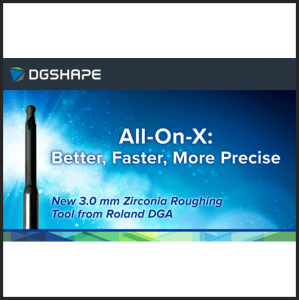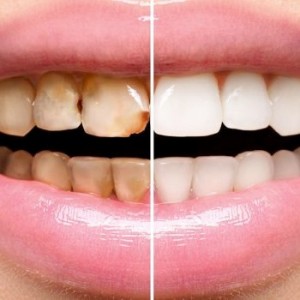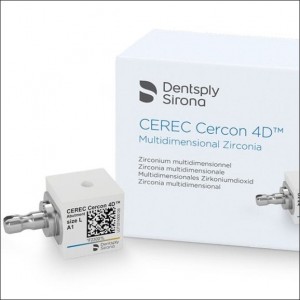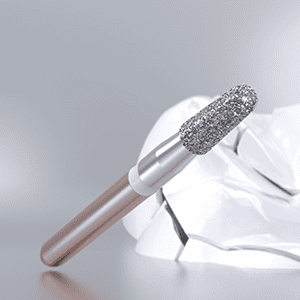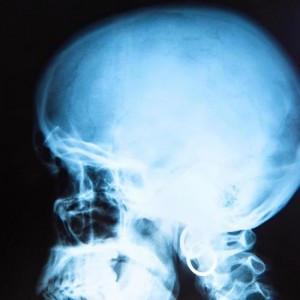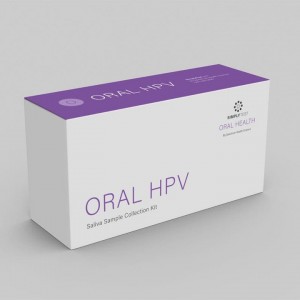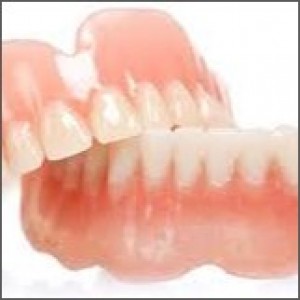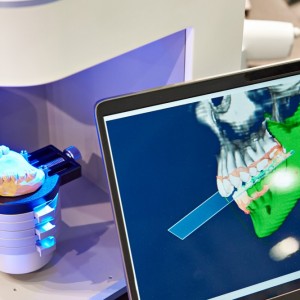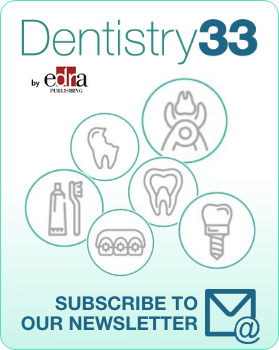
Ceramic implants with immediate and delayed loading in aesthetic regions
Alexandre Marques
Additional co-authors include Ana Paula Marques Paes da Silva, Mayla Kezy Silva Teixeira, Daniel Moraes Telles, Eduardo José Veras Lourenço
Introduction
Zirconia implants were introduced to the market in the 1990s as an alternative to titanium implants. The first zirconia implants were single-piece implants, which gives them greater mechanical stability and less risk of fracture. However, they have limitations such as: the need for a perfect three-dimensional positioning, as the poor positioning of the implant may imply the need for refinement of the most coronal portion of the implant, which may generate small cracks that would impair its resistance to fracture; it is only possible to install retained cemented prostheses; complications in wound healing and unintentional loading during the healing period, particularly in cases where primary stability has not been achieved.
More recently, two-piece implants have emerged that can minimize these problems, providing prosthetic versatility, with the possibility of angling the abutment, as well as better positioning of the implant.
Thus, the aim of the present case report is to describe two different approaches, in the same patient, with two-piece ceramic implants: Immediate implantation with immediate loading using a cemented abutment and immediate implantation with delayed loading using a zirconia healing cap during the period osseointegration, to later install a retained screw prosthesis.
Case report
This study was submitted to the ethics committee of the State University of Rio de Janeiro (UERJ-RJ) and approved under number 5.598.463. All participants were previously invited and informed about the study and signed an informed consent to participate, and all ethical aspects were followed.
A 68-year-old female patient with hypertension, came to the office reporting pain and mobility on upper and lower right first premolars. She was indicated by an endodontist who contraindicated endodontic retreatment, since the upper premolar already had bone loss and mobility and the lower premolar had an extensive periapical lesion, in addition to mobility. Tomographic examination confirmed bone loss in the teeth involved and the presence of endodontic infection associated with the root of the lower right premolar (figure 1a and 1b). The clinical examination confirmed the mobility of both teeth, spontaneous pain and a high smile line (the patient showed a lot of gum when smiling). She was instructed on the need to extract these teeth and on the details of how the surgical procedure would be performed. The advantages and disadvantages of Titanium and Ceramic (Zirconia) implants were explained. As previously mentioned, the patient had a high smile line and a high degree of aesthetic demand, which made her opt for the ceramic implant.
Thus, using computed tomography, the extraction and installation of two two-piece ceramic implants (Neodent Zi Ceramic Implant®– Curitiba – Brazil - upper premolar - 4.3x13mm (figure 2) and lower premolar - 4.3x11.5mm figure 3)) were planned in fresh sockets with immediate loading.
The extractions were performed with manual periotomes and forceps to lift them from within the socket, followed by curettage and cleaning of the sites with saline solution and the installation was performed according to the manufacturer's guidelines (Neodent Zi Ceramic Implant – Curitiba – Brazil).
The insertion torque of the upper right first premolar was 40 Ncm and this primary stability allowed immediate loading. The torque insertion in the lower premolar was 20Ncm, making immediate loading unfeasible. Thus, in the implant of the lower right first premolar, a healing abutment with a diameter of 4.5 mm and a transmucosal height of 1.5 mm (Figure 5) was installed to carry out late loading, after the period of osseointegration. An abutment for cemented prosthesis measuring 4.5mmx5.0mmX2.5mm (CR Zi Pillar®) was installed on the upper premolar and a provisional restoration was made in self-curing acrylic resin. The filling of the socket was only necessary in the region of the upper tooth, where substitute bone graft material was used (Straumann® Maxresorb® 0.5-1.0 mm – 0.5cc) (figure 6). It wasn’t necessary to perform a suture, as the alveoli were properly closed with the provisional (upper) (figure 7) and with the zirconia healer (lower) and at the end of the procedure, a final radiographic image of the two regions were taken (figure 8a and 8b).
Three months later, without any type of intercurrences, the temporary crown was removed from the upper implant to mold the abutment to receive a cement-retained crown and the healing cap was removed from the lower implant to mold the implant platform for the fabrication of a screw-retained crown (Figure 9 and 10). To take the impression, a closed impression transfer was used on the CR Zi Pillar® (upper) and an implant transfer (lower) with a closed impression. The gingival emergence profile was copied with the aid of self-curing flow resin. Then, a conventional impression was made with the addition of silicone with mass and regular body, and two lithium disilicate crowns (Emax®) were made (figure 11 and 12). The installation of both crowns followed the prosthetic protocols, and the crowns were fixed on the abutments with adhesive cement (Dual RelyX™ U200 - 3M) (figure 13a, b and c and 14). The lower premolar crown was cemented out of the mouth and then the set (abutment and crown) was placed on the implant. After installing the definitive crowns, new frame radiographs were taken, making it possible to observe the adaptation of the prosthetic work and the maintenance of the bone tissue around the implant (figure 15a and b).
At the end of the treatment, using a visual analogue scale (VAS), the patient was asked about her degree of satisfaction with the esthetics obtained and declared that she was "very satisfied" (figure 16).
The patient remains in periodic follow-up after nine months of implant installation and, up to the present time, there were no biological or prosthetic complications.
Discussion
This case report aimed to describe the clinical and radiographic performance of 2 two-piece zirconia implants placed in the same patient, at the same time, in the region of the upper and lower right first premolars. The two implants were installed in fresh sockets (immediate), the upper one with immediate loading and the lower one with delayed loading. After nine months of follow-up, no technical or biological complications were observed, demonstrating clinical and radiographic success of osseointegration and satisfactory preservation of the shape of soft and hard tissues, including the natural color of the peri-implant tissues after this period and patient satisfaction. Another study using this ceramic implant system showed results like ours after 12 months.
The accumulation of bacterial plaque on the surfaces of implants or prosthetic components is a critical problem and can be a triggering factor for peri-implant diseases. Some studies have shown that the zirconia surface has less affinity for bacterial plaque when compared to titanium surfaces. In figures 9 and 10 it is possible to observe the peri-implant tissues free of inflammatory processes and with a healthy aspect, as well as in another clinical study with a 6-year follow-up, where the implants showed a low rate of plaque and bleeding, also indicating soft tissues healthy peri-implants. In this same research, as well as in our study, the authors observed that the marginal bone levels remained stable over time.
At the end of the treatment, the patient reported being "very satisfied" when questioned about her degree of satisfaction using the VAS (figure 16), following the example of another study that investigated the performance of zirconia implants after six years.
Conclusion
Through this case report is possible to conclude that two-piece ceramic implants present greater prosthetic flexibility when compared to single-piece ceramic implants. The manufacture of cemented and screw-retained crowns is possible. Furthermore, two-piece implants can be loaded late when primary stability is not achieved, and the implant won’t be exposed to masticatory loads during the period of osseointegration. Still according to the present case report, the clinical and radiographic results demonstrated that this new two-piece zirconia implant presents favorable performance in relation to osseointegration and maintenance of peri-implant health.
References
Pieralli S, Kohal RJ, Jung RE, Vach K, Spies BC (2017) Clinical outcomes of zirconia dental implants: a systematic review. (“Ceramic vs. titanium implants: When to choose which? - Nobel Biocare Blog”) J Dent Res 96:38–46. https://doi.org/10.1177/0022034516664043
Cionca N, Hashim D (2000) Mombelli A (2017) Zirconia dental implants: where are we now, and where are we heading? Periodontol 73:241–258. https://doi.org/10.1111/prd.12180
Hashim D, Cionca N, Courvoisier DS, Mombelli A. A systematic review of the clinical survival of zirconia implants. Clin Oral Investig. 2016; 20:1403-1417.
Thomé G, Uhlendorf J, Vianna CP, Caldas W, Bernardes SR, Trojan LC. Clinical and radiographic success of injection-molded 2-piece zirconia implants submitted to immediate loading: A 12-month report of two cases. Clin Case Rep. 2021 Dec 4;9(12): e05118. doi: 10.1002/ccr3.5118.
Oh TJ, Yoon J, Misch CE, Wang HL. The Causes of Early Implant Bone Loss: Myth or Science. J Periodontol 2002; at 73:322-333
Scarano A, Piattelli M, Caputi S, Favero GA, Piattelli A. Bacterial adhesion on commercially pure titanium and zirconium oxide disks: an in vivo human study. J Periodontol. 2004 Feb;75(2):292-6. doi: 10.1902/jop.2004.75.2.292. PMID: 15068118.
Cionca N, Müller N, Mombelli A. Two-piece zirconia implants supporting all-ceramic crowns: a prospective clinical study. Clin Oral Implants Res. 2015; 26:413-418.
Norbert Cionca; Dena Hashim; Andréa Mombelli; (2021). Two‐piece zirconia implants supporting all‐ceramic crowns: Six‐year results of a prospective cohort study. Clinical Oral Implants Research, doi:10.1111/clr.13734.
 Related articles
Related articles
Kuraray Noritake Dental Inc., a global leader in dental material innovation, today launched KATANA Zirconia ONE For IMPLANT at Dentsply Sirona World (DS World).
Products 22 September 2025
Roland DGA has introduced the ZDB-150D-US 3.0 mm roughing tool, developed specifically for full-arch zirconia applications.
This systematic review aimed to provide an overview of zirconia implants as well as regarding the outcome of the implant-restorative complex in preclinical studies.
Products 01 September 2025
Dentsply Sirona Releases Innovative CAD/CAM Zirconia Block and Abutment Resin Cement
The CEREC Cercon 4D Multidimensional Zirconia Abutment Block combines high strength with aesthetics for both hybrid abutments and hybrid abutment crowns.
Rocky diamond bur is engineered to help dentists stay in control when the case is tedious and time is tight
 Read more
Read more
Much like EMTs rushing to the scene after an accident, stem cells hurry to the site of a skull fracture to start mending the damage. A new finding has uncovered the signaling mechanism that triggers...
Products 05 November 2025
SimplyTest has launched a groundbreaking saliva-based test to detect high-risk strains of oral human papillomavirus (HPV), a major cause of oropharyngeal cancers.
News 05 November 2025
Perimetrics, Inc., a dental technology company pioneering quantitative diagnostics, announced today that the U.S. Food and Drug Administration (FDA) has granted clearance for the InnerView...
News 05 November 2025
On October 15, open enrollment for Medicare began nationwide. Hundreds of thousands of seniors in New Jersey will once again face the challenge of finding the right Medicare coverage, including the...
Digital Dentistry 04 November 2025
Digitalisation is an expanding field in dentistry and implementation of digital teaching methods in dental education is an essential part of modern education.


















